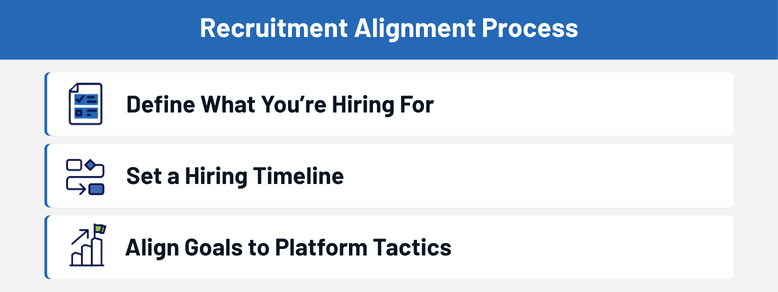How to Build a Social Media Recruiting Strategy That Delivers Results
Key Takeaways
- A strong social media recruiting strategy aligns tools with measurable hiring goals.
- Employer branding is essential to social recruiting success.
- Using data helps refine social media recruiting tactics for better ROI.
- Candidate experience must be built into every social recruiting step.
- Right-fit platforms depend on your industry, audience, and job roles.
- Tracking recruiting metrics like time-to-fill and engagement rate proves value.
Social media has become a cornerstone of modern recruitment, but without a clear strategy, it’s just noise. To turn engagement into actual hires, you need a social media recruiting strategy built on goals, brand clarity, and measurable actions.
This guide helps your team develop a strategy that connects the right message with the right talent, on the right platforms, and proves its ROI.

Start With Your Hiring Goals
Too often, teams treat social recruiting like a branding exercise. They post job listings or company updates without tying them to measurable outcomes. Filling positions end up taking longer than it needs to.
Here’s a better process.
1. Define What You’re Hiring For
Break down your immediate and near-term needs.
- Role types. Are you hiring developers, network engineers, help desk staff, or cybersecurity experts?
- Seniority levels. Entry-level hires need a different approach than executive searches.
- Volume. Do you need one specialist or 50 help desk technicians?
Each of these variables affects which platforms you use, how you create your message, and what success looks like.
2. Set a Hiring Timeline
Speed matters. Some roles need to be filled in days; others may be part of a long-term pipeline.
Define whether you’re:
- Filling urgent vacancies (short-term, transactional)
- Building bench strength (medium-term, proactive)
- Establishing an employer presence for future hires (long-term, brand-first)
Your content cadence, call-to-actions, and tool usage will change depending on your time horizon.
3. Align Goals to Platform Tactics
Once goals are established, connect them to platforms and tactics that make sense for your audience.
Here are some general guidelines to follow.
When your goals are clear, you’re better positioned to create a strategy that links specific actions to those outcomes.
Choose the Right Platforms for Your Audience
Not every platform fits every role or industry. Where you show up matters just as much as what you post.
Here’s a quick overview of how each platform stacks up for talent sourcing:
- LinkedIn. Ideal for high-skill, senior, or specialized roles. Strong for tech and healthcare IT.
- Facebook. Better for local recruiting, high-volume roles, or quick-turn positions.
- Instagram. Great for showing culture and values, especially if your audience skews younger.
X (Twitter). Limited reach, but useful for niche networking and real-time job promotion. - TikTok. Emerging for Gen Z and hourly roles, especially when authenticity leads the message.

Build an Employer Brand That Resonates
People follow people, not job boards. If you want to stand out, focus on employer branding that reflects real experiences beyond corporate messaging.
Build your brand with three key pillars:
- Purpose. Why does your work matter?
- People. Who are the individuals behind your product, platform, or mission?
- Path. What growth, learning, or development do you offer?
Avoid overly produced videos or stock images. Instead, share day-in-the-life posts, project highlights, team wins, and employee shoutouts. Let your team’s voice shine through.
Create a Content Plan With Candidate Experience in Mind
Your social feed is a preview of what it’s like to work at your organization. That means your candidate experience begins long before someone clicks “apply.”
Every post, comment, and reply sends a message about what it’s like to work at your company. Consistent, engaging content reflects who you are as an employer and how you treat people during the hiring process.
A weekly content cadence might look like this:
- Monday: Engage. Ask a question, share a win, celebrate an employee.
- Wednesday: Inform. Share behind-the-scenes content or team stories.
- Friday: Promote. Feature an open role or a call-to-action.
- Daily: Respond. Reply to comments, follow up on DMs, and reshare candidate content.
Aim for 80% value and 20% promotion. When your content is consistently useful or interesting, candidates stick around, and they’re more likely to act when it’s time to hire.

Use Tools and Metrics to Track ROI
The most polished posts mean nothing if they don’t move the needle. To maximize your social recruiting ROI, you’ll need to track what works and what doesn’t.
Here are core recruiting metrics to monitor:
- Time-to-fill. How long does it take to move from post to hire?
- Engagement rate. Likes, shares, and comments show how well your content connects with your audience.
- Application rate. This is the percentage of viewers who take the next step.
- Qualified candidate count. Look at volume and whether they are the right fit.
Social recruiting tools can help automate workflows, monitor performance, and surface actionable insights that improve both reach and results. Whether you’re managing multiple platforms or trying to connect campaign data with applicant flow, the right tools make a measurable difference in productivity and ROI.
Top social recruiting tools include:
- Hootsuite/Sprout Social (for scheduling and audience analytics)
- LinkedIn Recruiter (for proactive outreach and candidate pipelines)
- Google Analytics (to track how social drives traffic to job pages)
Using these tools ensures your team can stay consistent without being overwhelmed, and that your efforts are tied directly to the metrics that matter, like application rates and qualified candidate volume.
Have more questions? See our FAQ below for answers.
Let’s Build Your Recruitment Strategy Together
Building a scalable, measurable social media recruiting strategy doesn’t require a huge budget, but it does require focus, structure, and the right partner.
But strategy doesn’t always get the attention it needs. When hiring demands are high, it’s easy for social efforts to become reactive instead of purposeful.
GDH helps teams source qualified IT professionals and build structured recruiting strategies that align with business needs—on social and beyond. Contact us to access IT professionals who can accelerate your hiring results.
FAQs
What makes a social media recruiting strategy successful?
Clear hiring goals, authentic branding, the right platforms, and trackable metrics can boost your social media recruiting strategy’s success.
Which social platform works best for IT recruiting?
LinkedIn is typically best for IT recruiting, but Instagram can also be highly effective, depending on your audience.
How often should we post job-related content?
Aim to post job-related content 3-5 times a week, mixing job content with culture, values, and team updates.
What should we measure in social recruiting?
Essential metrics in social recruiting include time-to-fill, engagement rate, application rate, and number of qualified applicants.
Can small companies compete on social?
Small companies can compete on social media when it comes to recruiting. Authenticity and consistency matter more than a big budget.
What tools help with social recruiting?
Tools like Hootsuite, Sprout Social, and LinkedIn Recruiter help schedule, source, and measure your efforts.








